Physical Address
304 North Cardinal St.
Dorchester Center, MA 02124
The earliest description of an acquired arteriovenous fistula (AVF), the abnormal communication between an artery and vein, is attributed to William Hunter, who in 1761 reported two cases of brachial AVFs following attempted phlebotomy. He also described the adaptive dilation of the artery and veins proximal to the AVF, as well as the associated tremulous motion, (“thrill”) and hissing noise (“bruit”). ,
AVFs were infrequently identified and diagnosed until the introduction of high-speed projectiles during 19th-century conflicts, which altered the magnitude and complexity of military injuries. Successive military conflicts and the increase in blunt, penetrating, and iatrogenic trauma among civilians have resulted in a greater number of vascular injuries (VIs), pseudoaneurysms (PSAs) and, as a consequence, acquired AVFs.
AVFs may either be congenital or acquired. Vascular malformations, including congenital AVFs, are discussed in Chapters 170 , Congenital Vascular Malformations: General Considerations; 171 , (Congenital Vascular Malformations: Surgical Management) and 172 , (Congenital Vascular Malformations: Endovascular Management). The focus of this chapter is acquired AVFs, predominantly due to trauma and the small number which occur spontaneously, usually from erosion or rupture of an atherosclerotic or infected aneurysm or PSA into an adjacent vein.
The anatomic distribution of VIs and AVFs is related to the mechanism of injury and varies between military personnel and civilians. Blast/explosives and mortars account for 70% and gunshot wounds (GSWs) 30% of VIs among military personnel, whereas penetrating trauma due to GSWs or stab wounds (SWs) account for the majority (61.7%) of civilian VIs reported in the Department of Defense Trauma Registry and the National Trauma Data Bank. , The incidence of VIs in the conflicts in Iraq and Afghanistan range from 4.4% to 17.6% comprised of extremity trauma (72%) and injury to the torso and cervical regions (17% and 11%, respectively). The lower extremity was the site of VI in 45% of cases. The more frequent occurrence of extremity VI among military personal is secondary to the use of protective body armor. The incidence of VIs among civilians with GSWs was 9.9% and involved the extremities (40.8%), abdomen/pelvis (33.6%), chest (10.1%), head and neck (6.7%), and extra-cavitary/face (8.7%).
In a series of 210 civilian traumatic AVFs reported by Robbs et al., SWs accounted for 63%, GSWs accounted for 26% and blunt trauma for 1%. AVFs due to SWs involve the cervico-mediastinal arteries in 54% to 75% of cases and most frequently (21%) the common carotid artery. Acquired AVFs involved the upper and lower extremities in 22% and 20% of cases, respectively, whereas thoracic and abdominal AVFs are encountered in 4% of patients. Rich et al. in a series of 558 PSAs and AVFs from the Vietnam Vascular Registry found that 85.4% of the AVFs were located in the extremities (upper 16.4% and lower 69%, respectively) ( Fig. 173.1 ). ,
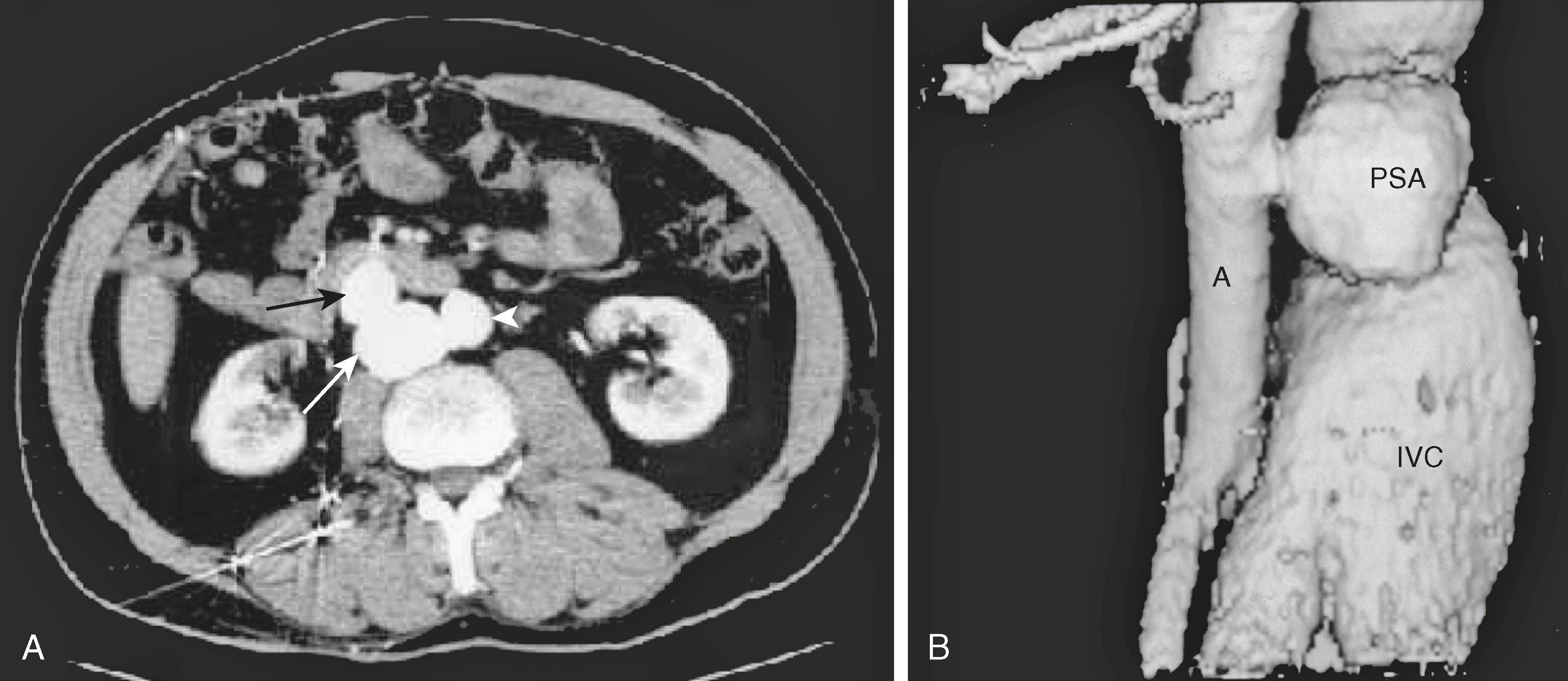
Iatrogenic injuries that cause AVFs usually result from percutaneous cardiac and vascular diagnostic and therapeutic interventions, central venous catheterization, orthopedic procedures on the lumbar spine and knee, diagnostic kidney and liver biopsies, and percutaneous insertion of biliary and urinary drainage catheters. The right common femoral artery (CFA) remains the most common site of iatrogenic injury (37%) in the lower extremities. The increase in the number of percutaneous interventions being performed would be expected to result in a greater number of iatrogenic AVFs. However, the use of micropuncture angiographic needles inserted under ultrasound (US) guidance and small diameter sheaths has significantly reduced the number of access site–related complications (1.9% vs. 4.3%) in patients undergoing coronary angiography. In a prospective study of 635 patients undergoing femoral access for noncardiac diagnostic or interventional procedures randomized 1:1 to receive either fluoroscopic or US-guided access, the authors found that although the use of ultrasound guidance allowed for more efficient and expeditious cannulation of the femoral artery, the rates of early or late complications did not differ between the two groups.
First described by Syme in 1831, rupture or erosion of an atherosclerotic, inflammatory, mycotic aortic or iliac aneurysm into the inferior vena cava (IVC), iliac vein ( Fig. 173.2 ), or retro-aortic left renal vein ( Fig. 173.3 ) can result in spontaneous AVFs. There have been a few isolated case reports of spontaneous AVFs in patients with syphilitic aortitis, HIV arteritis, and Marfan and Ehlers–Danlos syndromes. ,


Innominate artery injuries account for 0%–3% of civilian arterial injuries and result from GSWs, SWs or central venous catheterization of the internal jugular and subclavian veins. Fistulas between the innominate artery and the superior vena cava, innominate vein or its tributaries were present in 10% of patients in a series reported by du Toit et al. ( Fig. 173.4 ).
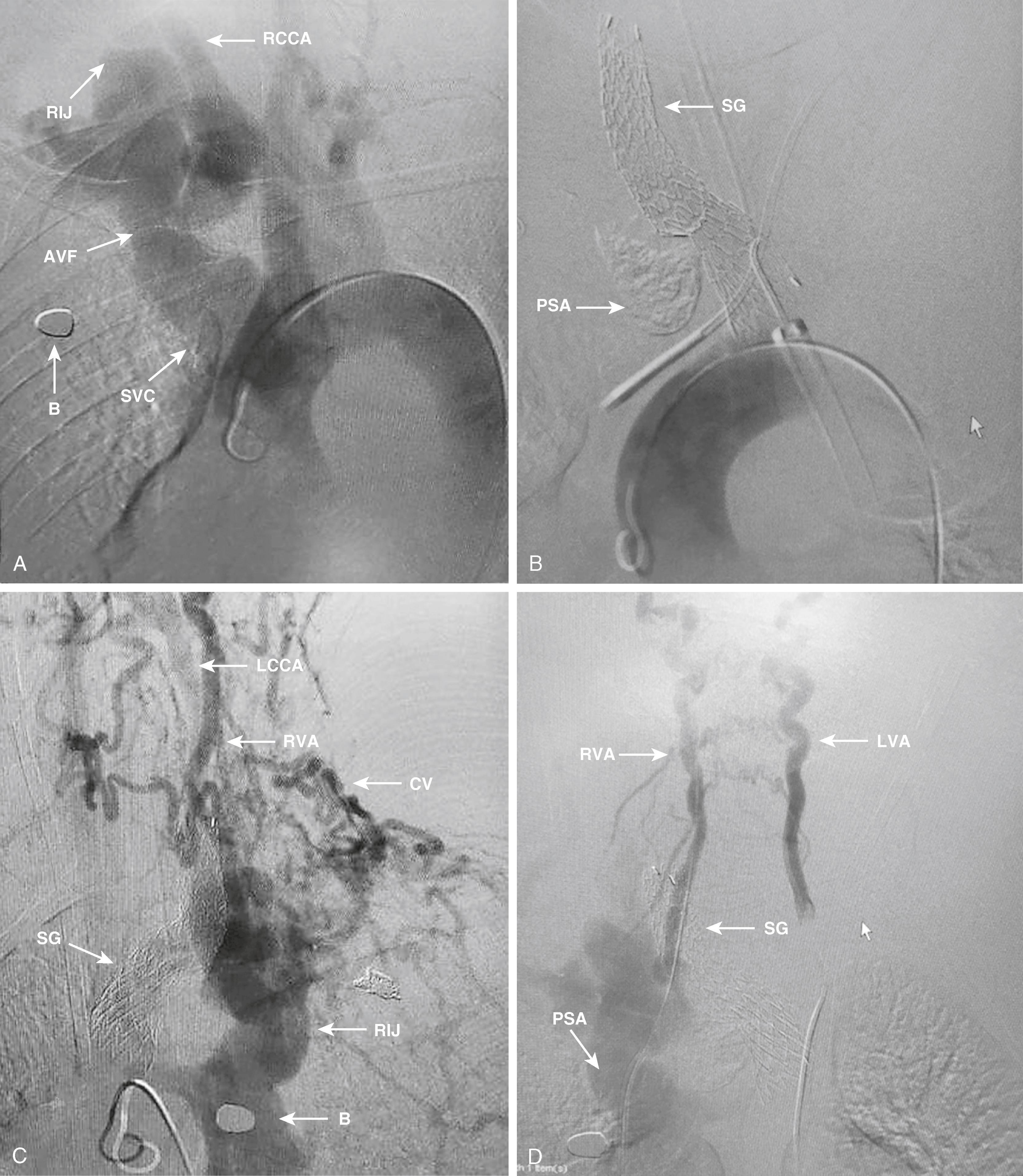
Carotid artery injury constitutes 5% to 11% of all arterial injuries and usually results from SWs or GSWs, therapeutic or diagnostic catheterization, or blunt trauma to the skull or cervical spine. AVFs between the carotid artery and internal jugular vein or its tributaries occurs following 4% to 27% of such injuries. , , ,
Vertebral artery AVFs occur in 0.7% to 7.4% of cases of penetrating trauma. The AVF is usually between the vertebral artery and the epidural venous plexus and/or jugular venous system. Iatrogenic injury during operative procedures on the cervical spine and catheterization of the internal jugular vein accounts for approximately two-thirds of cases, while cervical spine fractures due to blunt trauma, chiropractic manipulation, or closed head injury, GWs, and SWs for the remaining one-third. Spontaneous AVFs are rare usually due to an underlying collagen vascular disease such as neurofibromatosis type I, Marfan and Ehlers–Danlos syndromes.
Approximately 3% of all neck- and chest-penetrating trauma is associated with injury to the subclavian vein (44%), artery (39%), or both (17%). Inadvertent puncture of the carotid or subclavian arteries occurs in up to 8.4% of cases of attempted central venous catheterization, , and the incidence of AVFs following subclavian vein catheterization is estimated at 0.58%. Penetrating axillary artery injuries and fractures of the clavicle or first rib are rare causes of AVFs. ,
Upper extremity trauma accounts for 25% to 40% of all VIs. , The brachial and forearm arteries are involved in 10% to 22% of cases. The radial and ulnar arteries are frequently used for cardiac and endovascular interventions; AVFs occur in 0.02% to 0.04% of cases. Peripherally inserted central catheter (PICC) lines may also be complicated by AVFs.
Penetrating injuries due to GSWs, SWs, shrapnel injuries from IEDs, or following surgery for intertrochanteric or femoral neck fractures may result in femoral AVFs. , , The incidence of AVFs as a result of such injuries varies considerably between the military and civilian populations. In a review of 558 AVFs due to military injuries, 28% involved the superficial femoral or profunda femoris arteries, whereas in a civilian series of AVFs predominantly due to SWs, the CFA was involved in 12% of cases ( Fig. 173.5 ). Sporadic cases of spontaneous AVFs between the superficial femoral artery and vein have also been described. The CFA remains the most common site of iatrogenic AVFs, with an incidence of 0.06% to 0.86% when diagnosed by physical exam but 2.8% using duplex US (DUS). , Femoral AVFs are slightly more frequent after interventional than diagnostic procedures. The majority of AVFs close spontaneously: in one study, only 11% became symptomatic and required operative repair (OR). Femoral and external iliac artery AVFs are a rare complication of endovenous laser ablation for varicose veins. , The risk factors predisposing to iatrogenic femoral AVFs are listed in Box 173.1 .
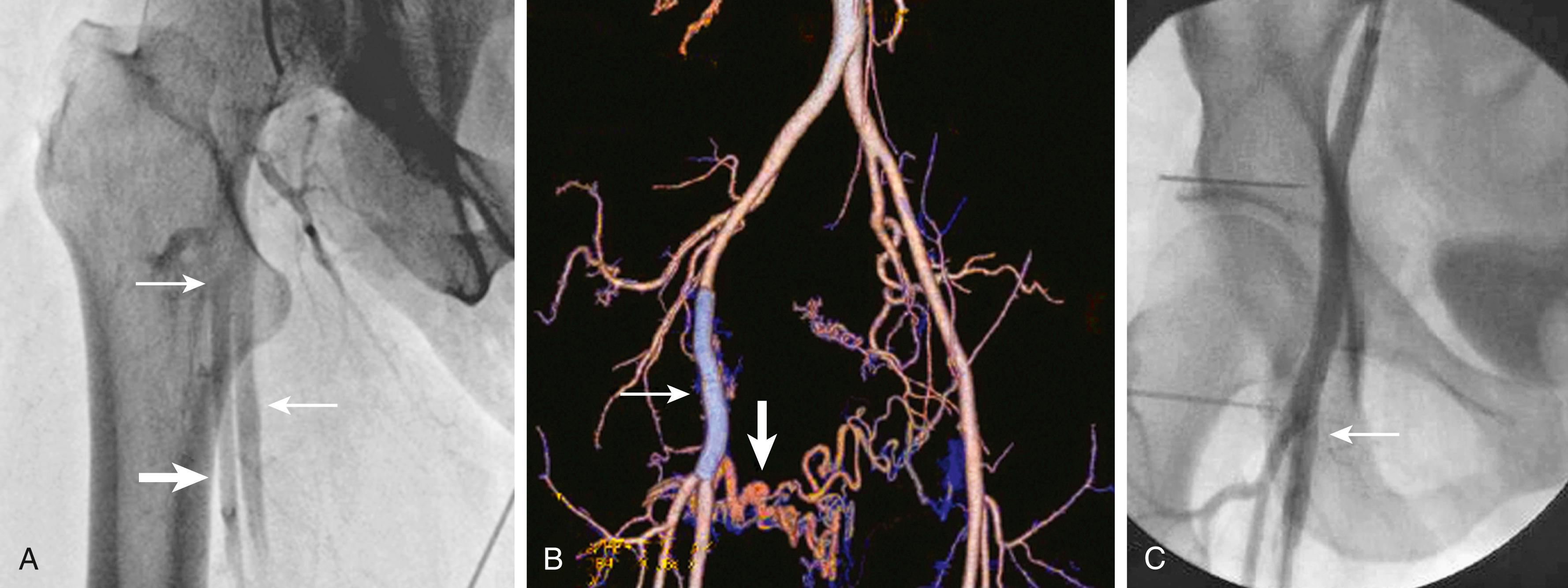
Popliteal AVFs have similar etiologies to femoral AVFs. They account for approximately 16% of AVFs reported in the Vietnam registry and 5% to 14% of civilian AVFs. , , Blunt trauma associated with comminuted femoral and proximal tibial fractures and orthopedic procedures on the knee may also be complicated by AVFs. , The number of iatrogenic popliteal AVFs can be expected to increase, due to the more frequent use of popliteal access for interventions to treat deep vein thrombosis and chronic venous insufficiency.
AVFs of the tibial and peroneal arteries are a recognized complication of comminuted fractures, blast fragment injuries, balloon catheter thrombectomy, and atherectomy of the tibial vessels ( Fig. 173.6 ). Approximately 24% of the AVFs reported in the Vietnam registry occurred in the tibial and peroneal arteries. The more frequent use of retrograde tibial access to recanalize occluded lower extremity arteries in patients with critical limb ischemia (CLI) may increase the risk of AVFs in these locations.
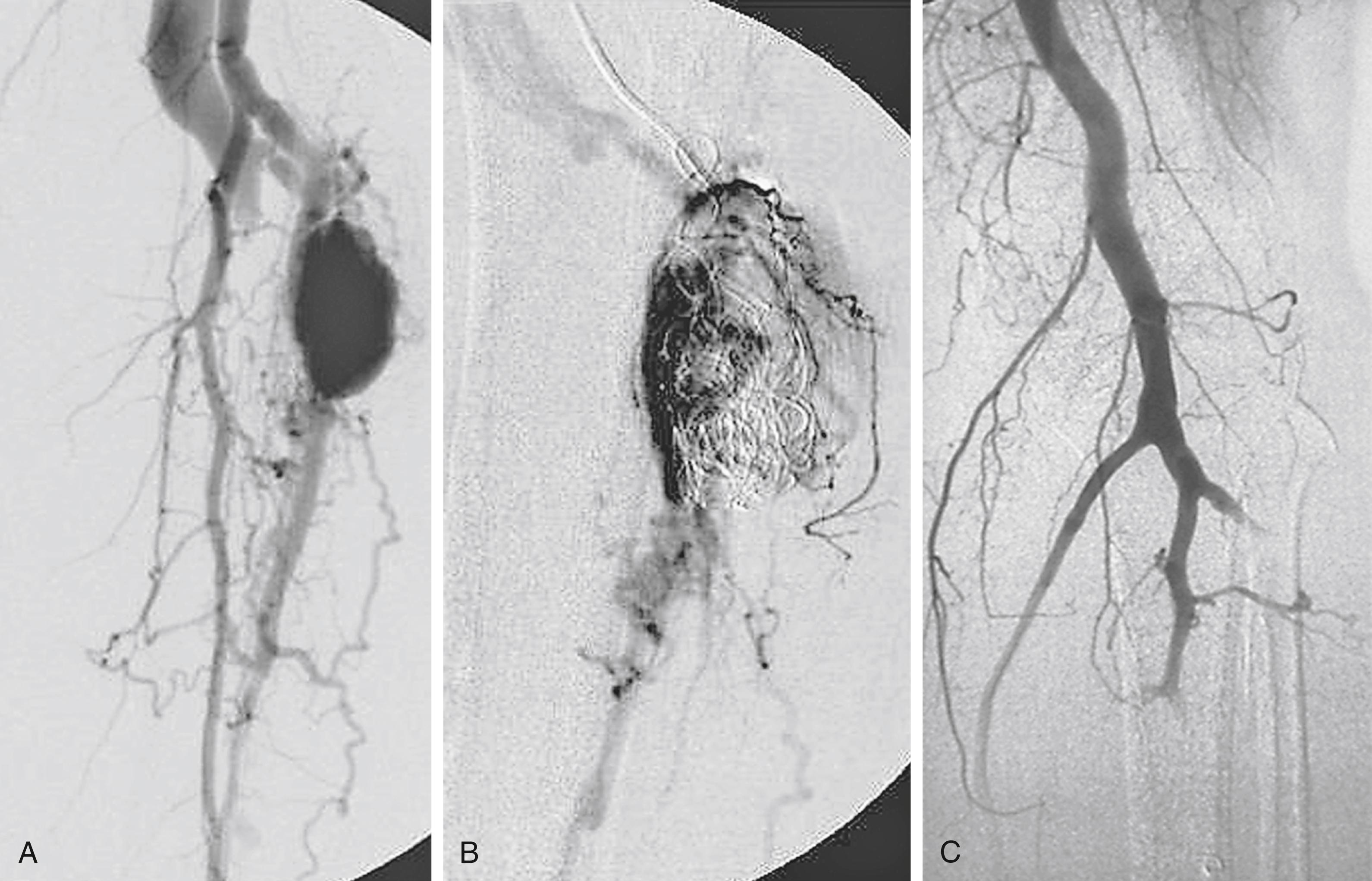
Rupture or erosion of an AAA into the IVC accounts for 80% to 90% of acquired aortocaval fistulas (ACFs). GSWs, shrapnel, SWs, iatrogenic injury, lumbar disk surgery, and nephrectomy account for the remaining 10% to 20% (see Fig. 173.1 ). Persistent or recurrent ACFs may occur due to the failure to detect or adequately repair the fistula, rupture of a para-anastomotic PSA into the IVC (distal anastomosis of aortic tube grafts), and ongoing pressurization of the aneurysm sac because of persistent endoleaks.
Iliac AVFs account for 0.4% to 1.4% of AVFs and are usually the result of rupture of an iliac aneurysm into an adjacent vein, penetrating trauma or lumbar disc surgery. , ,
VI occurs in up to 0.05% of lumbar disc procedures. Anatomic anomalies, such as a low aortic bifurcation at L4–L5 (18%) and degenerative changes of the anterior spinal ligament, may contribute to VIs in this location. VIs at the L3–L4 disc space predominantly involve the aorta and IVC; the majority of iliac VIs occur at the L4–L5 and L5–S1 disc space, where the common iliac arteries are most vulnerable to injury (right CIA 43%; left CIA 29%). ,
The majority of renal AVFs occur after renal biopsy in approximately 9% to 18% of patients. Factors predisposing to biopsy-related renal AVFs include use of a large-bore needle, lack of US or CT guidance when performing the biopsy, medullary penetration, and the presence of atherosclerotic vessels , ( Fig. 173.3 ). Iatrogenic causes resulting from surgical or percutaneous interventions including partial nephrectomy, mass ligation of the renal pedicle, guide wire arterial perforation during angiography or renal stenting, percutaneous nephron-lithotomy, laser lithotripsy and percutaneous nephrostomy tube placement comprise most of the remainder. Spontaneous renal AVFs may occur from the erosion of tumors, inflammatory processes, or of an aortic or renal aneurysm directly into a retro-aortic or normally located renal vein or its tributaries. , , , Isolated renal AVFs due to blunt and penetrating trauma are uncommon.
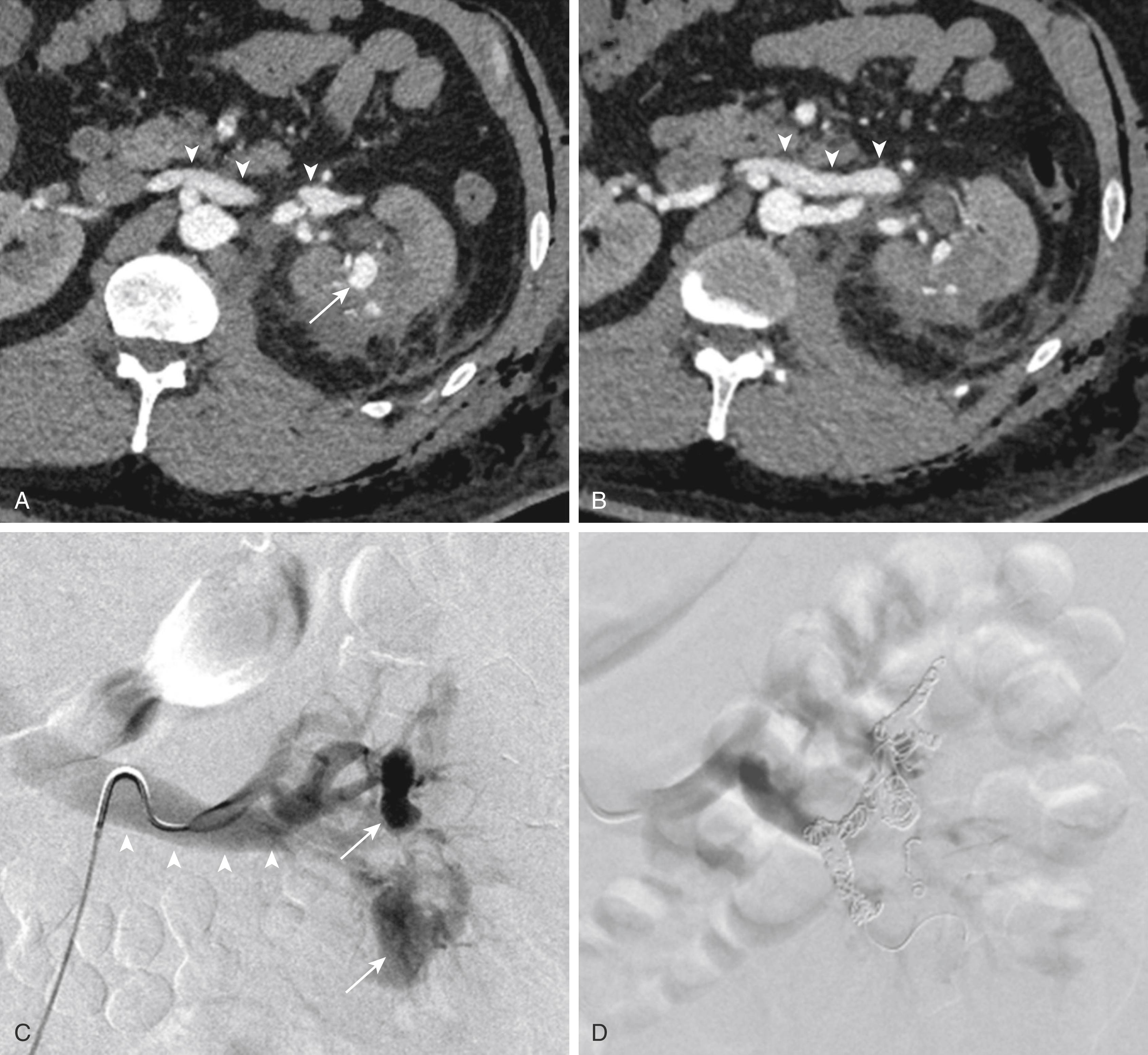
Splenic AVFs may result from blunt or penetrating intraabdominal trauma, mass ligation of the splenic pedicle, iatrogenic injury during splenoportography, and, rarely, erosion of a pancreatic pseudocyst into the splenic artery and vein. Forty-four percent of splenic AVFs are due to rupture of a noncalcified splenic artery aneurysm (SAA) into an adjacent vein; this may be the first indication of the presence of an SAA. , Hepatic AVFs are most commonly the result of penetrating or vehicular trauma but may occur after percutaneous needle biopsy, transhepatic diagnostic catheterizations, biliary drainage, or TIPS procedures ( Fig. 173.8 ). Hepatic AVFs may be either intrahepatic or extrahepatic and occur in 5.4% of patients after percutaneous needle biopsy. Hepatic artery aneurysms (HAAs) and carcinomas may also erode into an adjacent vein, resulting in an AVF. , , AVFs of the superior and inferior mesenteric arteries are rare and are usually the result of penetrating trauma, iatrogenic injuries, or mass ligation of the vascular pedicle during bowel resection. ,
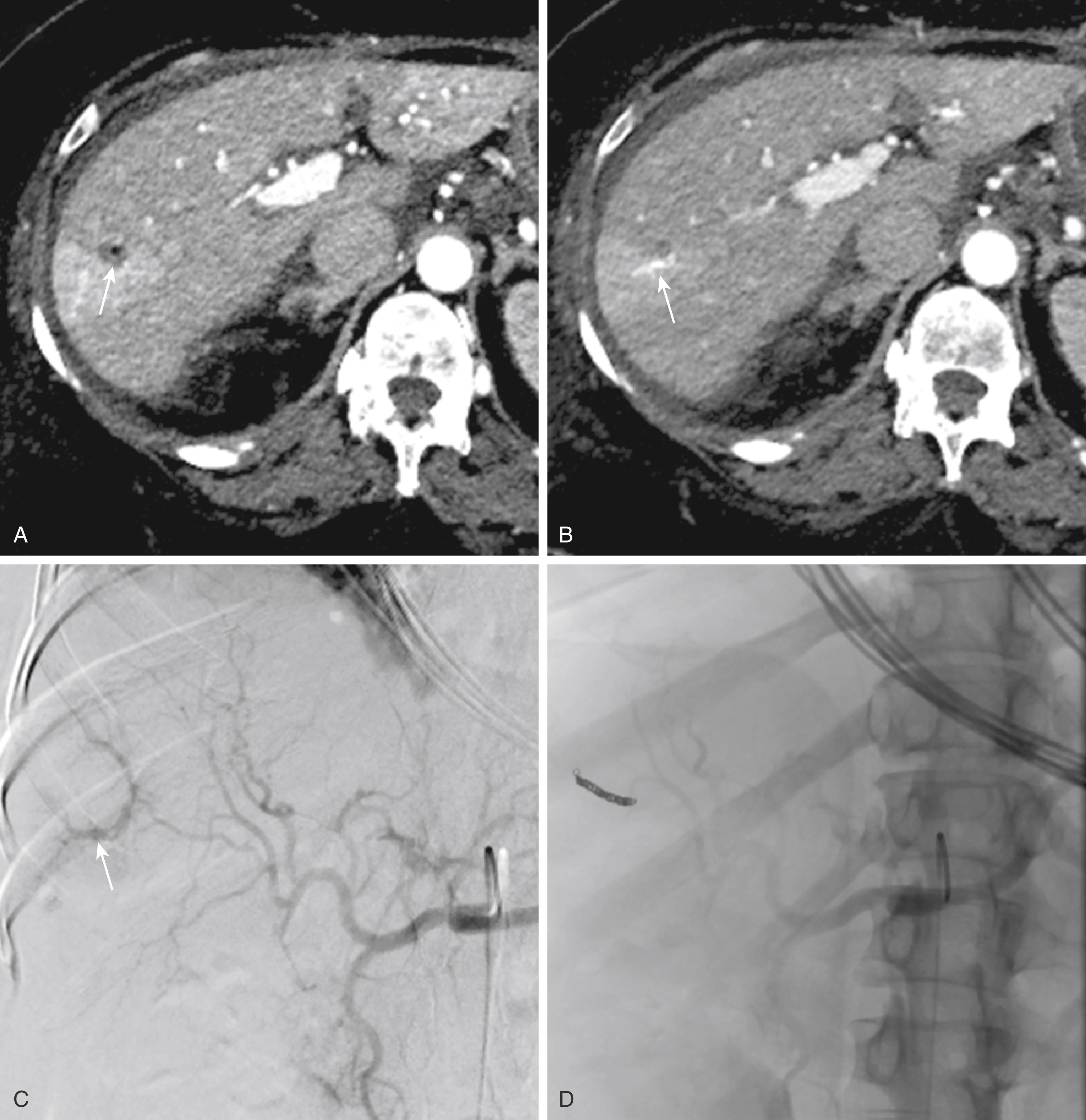
Acquired uterine AVFs are a rare complication of intrauterine instrumentation procedures, (diagnostic and therapeutic curettage, removal of retained placental products, IUDs, and hysteroscopy) myomectomy, and pathologic processes such as infection, trophoblastic disease, and malignancies involving the uterus. Uterine AVFs are frequently a single AV communication without involving the surrounding tissue. ,
Become a Clinical Tree membership for Full access and enjoy Unlimited articles
If you are a member. Log in here